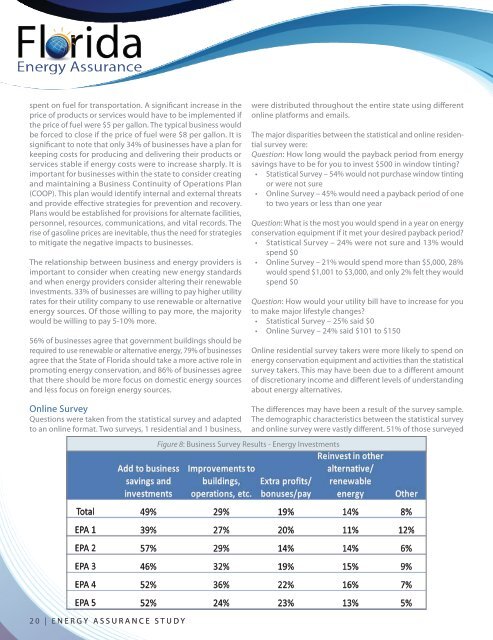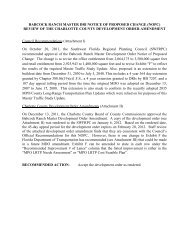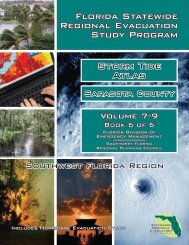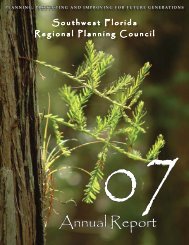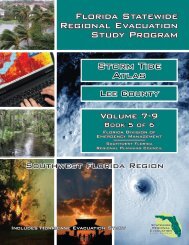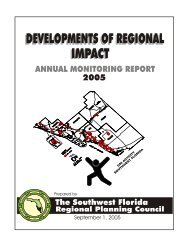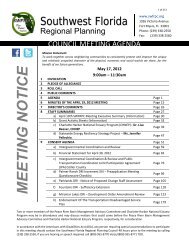Energy Assurance Study: Interim Report - Southwest Florida ...
Energy Assurance Study: Interim Report - Southwest Florida ...
Energy Assurance Study: Interim Report - Southwest Florida ...
- No tags were found...
You also want an ePaper? Increase the reach of your titles
YUMPU automatically turns print PDFs into web optimized ePapers that Google loves.
spent on fuel for transportation. A significant increase in theprice of products or services would have to be implemented ifthe price of fuel were $5 per gallon. The typical business wouldbe forced to close if the price of fuel were $8 per gallon. It issignificant to note that only 34% of businesses have a plan forkeeping costs for producing and delivering their products orservices stable if energy costs were to increase sharply. It isimportant for businesses within the state to consider creatingand maintaining a Business Continuity of Operations Plan(COOP). This plan would identify internal and external threatsand provide effective strategies for prevention and recovery.Plans would be established for provisions for alternate facilities,personnel, resources, communications, and vital records. Therise of gasoline prices are inevitable, thus the need for strategiesto mitigate the negative impacts to businesses.The relationship between business and energy providers isimportant to consider when creating new energy standardsand when energy providers consider altering their renewableinvestments. 33% of businesses are willing to pay higher utilityrates for their utility company to use renewable or alternativeenergy sources. Of those willing to pay more, the majoritywould be willing to pay 5-10% more.56% of businesses agree that government buildings should berequired to use renewable or alternative energy, 79% of businessesagree that the State of <strong>Florida</strong> should take a more active role inpromoting energy conservation, and 86% of businesses agreethat there should be more focus on domestic energy sourcesand less focus on foreign energy sources.were distributed throughout the entire state using differentonline platforms and emails.The major disparities between the statistical and online residentialsurvey were:Question: How long would the payback period from energysavings have to be for you to invest $500 in window tinting?• Statistical Survey – 54% would not purchase window tintingor were not sure• Online Survey – 45% would need a payback period of oneto two years or less than one yearQuestion: What is the most you would spend in a year on energyconservation equipment if it met your desired payback period?• Statistical Survey – 24% were not sure and 13% wouldspend $0• Online Survey – 21% would spend more than $5,000, 28%would spend $1,001 to $3,000, and only 2% felt they wouldspend $0Question: How would your utility bill have to increase for youto make major lifestyle changes?• Statistical Survey – 25% said $0• Online Survey – 24% said $101 to $150Online residential survey takers were more likely to spend onenergy conservation equipment and activities than the statisticalsurvey takers. This may have been due to a different amountof discretionary income and different levels of understandingabout energy alternatives.Online SurveyQuestions were taken from the statistical survey and adaptedto an online format. Two surveys, 1 residential and 1 business,Figure 8: Business Survey Results - <strong>Energy</strong> InvestmentsThe differences may have been a result of the survey sample.The demographic characteristics between the statistical surveyand online survey were vastly different. 51% of those surveyed20 | ENERGY ASSURANCE STUDY


